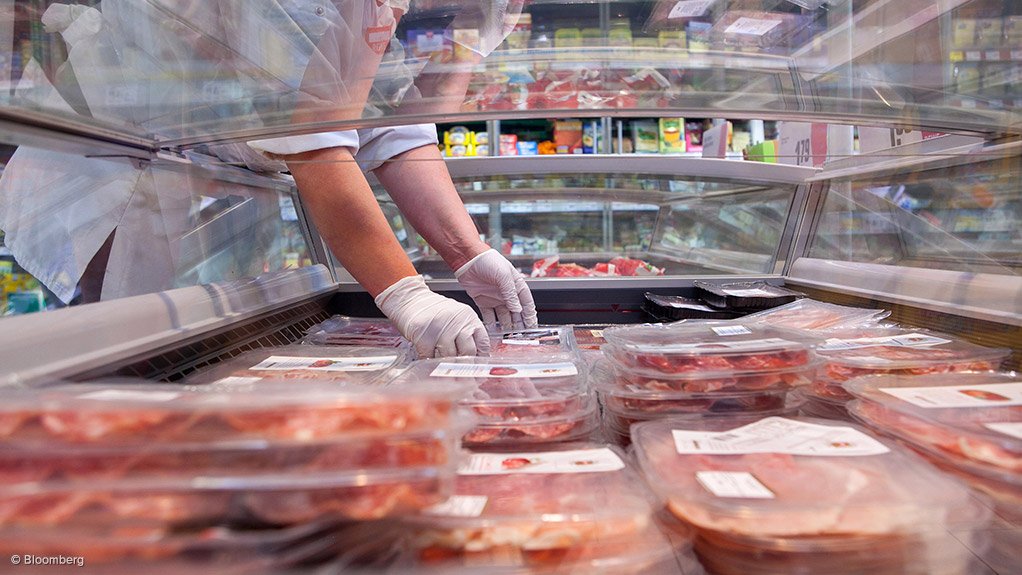South African food and non-alcoholic beverage (NAB) inflation – hereafter to be referred to as food inflation, for short – continued its renewed acceleration in October, the Bureau for Food and Agricultural Policy (BFAP) has reported, in its latest “Food Inflation Brief”. After five months of declining food inflation, in September it moved up again, slightly, followed by a noticeable increase in October.
In year-on-year (y-on-y) terms, food inflation ran at 8.7% last month, and in month-on-month (m-on-m) terms was at 1.5%. This compared with the consumer price index (CPI) headline inflation figures of 5.9% (y-on-y) and 0.9% (m-on-m). (CPI headline inflation is also trending up again.) Food inflation contributed 1.6 percentage points to the y-on-y CPI headline inflation figure, and 0.3 percentage points to the m-on-m number.
“In October 2023 [y-on-y] inflation for food and [NAB] was mainly driven by inflation on bread and cereals, vegetables and dairy products, followed by meat, NAB, as well as sugar and sugar-rich foods,” reported the BFAP. “Global food commodity prices, which the [Food and Agricultural Organisation] Food Price Index measures monthly, were marginally down (-0.5%) in October from September and lower by 10.9% compared to the same period in 2022.”
The food categories which recorded the highest y-on-y inflation in South Africa last month were vegetables (23.6%), followed by sugar-rich foods (17.6%), dairy and eggs (12.4%), bread and cereals (8.8%), fruit (8.5%), NAB (8.4%), fish (7.7%) and meat (3.4%), while oils and fats saw deflation of 5.6%. In m-on-m terms, vegetables again had the highest inflation, at 7.1%, with fruit next (5.8%) and thereafter dairy and eggs (2.5%), oils and fats (1.3%), sugar-rich foods (0.9%), NAB (0.8%), meat (0.6%), bread and cereals (0.3%) and fish (0.1%).
Commonly bought food items with y-on-y inflation last month equal to or greater than 30% were (in the order and categorisation given by the BFAP) potatoes, sweet potatoes, broccoli, cauliflower, papaya and bananas. Those with y-on-y inflation from 20% to just under 30% were rice, instant noodles, frozen potato chips, polony, onions, pumpkin, sugar, tea, whiteners and soup powder. Those items with y-on-y inflation from 10% to just under 20% were fresh chicken portions, chicken giblets, hake, fish fingers, bacon, cucumber, spinach, apples, pears, fruit juice, coffee, maize-based food drink, Rooibos tea, mineral water, condensed milk, yoghurt, powdered milk, gouda cheese, feta cheese, peanut butter, canned baked beans, sugar-rich foods, baking powder, chutney, vinegar and instant yeast. However, some food items did experience y-on-y deflation; these were white bread, beef (offal, sirloin, rump steak, fillet, mince, brisket, stew, chuck, T-bone), mutton/lamb (rib chops, neck, leg, stew), fresh whole chicken, eggs, lettuce, beetroot, canned mixed vegetables, pineapple, fresh cream and plant oil.
The rand depreciated by 5.1% compared with the US dollar, y-on-y, in October. While in October last year the rate had been R18.12/$1.00, last month it was R19.05/$1.00. The BFAP also noted that South African CPI rate for fuel, in October, had been up 11.2% y-on-y and up 6.5% m-on-m. The CPI figure for ‘electricity and other fuels’ had been up 15.2% y-on-y and 0.1% m-on-m.
The cost of the BFAP’s Thrifty Healthy Food Basket (THFB) increased in October by 8.4%, or R341, y-on-y, and by 1.9%, or R67, m-on-m. The THFB is composed of 26 nutritionally-balanced food items from all the food groups. It is designed to feed a reference family of two adults and one older and one younger child, for a month. Assuming that family is earning two minimum wages and benefitting from child grants and school feeding, the THFB would have cost it 31.7% of its total income last month.
“As it stands, factors beyond the control of farmers are driving production costs up, resulting in greater volatility in volumes presented to the market,” concluded the BFAP. “A weaker rand, which affects the cost of imported inputs such as fuel and fertiliser, together with the persistent pressure of loadshedding, remain the major drivers of heightened input cost, influencing farmers’ enterprise (crop) and production decisions, while also driving up costs through the value chain.”
EMAIL THIS ARTICLE SAVE THIS ARTICLE ARTICLE ENQUIRY
To subscribe email subscriptions@creamermedia.co.za or click here
To advertise email advertising@creamermedia.co.za or click here











